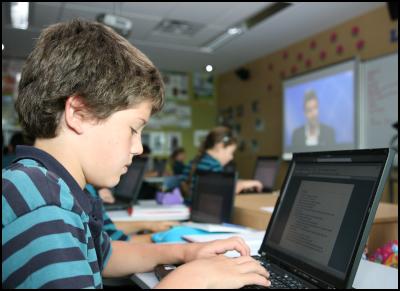NEAL fibre network to reach potential in 2010
MEDIA RELEASE
29 April 2010
NEAL network to reach potential in 2010

Broadband operating costs have been slashed for a number of North Shore schools thanks to the NEAL fibre network.
In fact, the NEAL Education Trust says 10 schools which negotiated a bulk contract rate from a sole internet service provider are collectively saving tens of thousands of dollars annually.
It is a trend Vector, the company behind the fibre network believes will become more prevalent if it is successful in its bid to partner with the Government in laying an Auckland wide ultra-fast broadband network over the next seven years.
In fact, the company has embarked on a major public awareness campaign, including a popular television commercial and social media programme, to help Aucklanders better understand the immense benefits of fibre as a key infrastructural platform for New Zealand in years to come.
Trust spokesperson and Kristin School director of ICT services Jason MacDonald now wants to extend the model to the remaining schools on the NEAL network. He says the Trust has been working with them to illustrate the educational and operational benefits of such a fast network.
He is also hoping for a cash boost from the Ministry of Education’s School Network Upgrade Project (SNUP) and the newly announced ICT Regional Professional Development Clusters to help realise the potential of NEAL, a programme he describes as leading edge.
SNUP is designed to assist schools to be ultra-fast broadband ready through upgrades to school’s individual networks.
The Trust has just secured a $300,000 contract through the MOE’s Regional Professional Development funding to provide teaching, learning and leadership professional development focused on the use of ultra-fast broadband. It is awaiting the outcome of that application.
Combined, Mr MacDonald hopes the two projects will help deliver the technology to use the network and provide the teaching and learning professional development for schools.
Through the NEAL development, Vector built a fibre network to over 60 North Shore schools, libraries and community centres – taking fibre connections to the door to ensure ease of connectivity.
Mr MacDonald says 36 schools are currently utilising the network but he plans to have the rest on board by the end of the year as part of the Ministry of Education’s ‘National Education Network’ trial, which will give over 30,000 students and 47 schools access to the high performance network. More schools are asking to join on a weekly basis, he says.
“To have built the largest regional active schools network on a volunteer basis is a great effort. Our goal is sustainability of that,” says Mr MacDonald.
“I guess you can equate the NEAL fibre loop to a race car - if you haven’t driven one before you don’t really know what to do with it.
“But when a school can have over 1000 computers logged on to the internet at one time, it is in their interests to have the fastest connectivity possible and that’s what open access fibre allows.
“The NEAL loop is a gigabit network but the speed of connection per school depends on their ICT infrastructure and that’s what we are advising on so they can get the most out of this.”
Mr MacDonald says the network is providing global connectivity and has allowed Kristin students to work on projects with schools from abroad. The network speed allows instant uploading and downloading of large files.
“Students can post comments on blogs and we are also able to upload video files quickly and easily. From a staff development perspective it means teachers can take part in conferences without leaving the school because of high definition, remote video conferencing. That is a big cost and time saver for schools,” he says.
Students are also able to complete distance learning by being part of a virtual projects at other schools.
He says fibre connectivity is also opening up the use of interactive whiteboards and multi-touch screens.
“Fibre is the technology foundation that brings alive the potential of learning devices like interactive whiteboards because you can share the whiteboards with other schools on the NEAL network. But it is really up to the school leaders within schools to decide how they can best utilise the technology.
“The challenge for all school leaders around the world is working out how fibre based technology can enhance learning and thought processes to create a dynamic environment. There is a plethora of exciting service providers and applications coming on board now and there will be lots more in future,” says Mr MacDonald.
“Schools are encouraged to work with the NEAL Education Trust and Vector. Our ethos remains firmly around resource and knowledge sharing and it is really encouraging to see more schools wanting to come on board - especially with the work going in 'around the Ministry of Education's National Education Network linking schools together.”
ENDS


 Keith Rankin: Make Deficits Great Again - Maintaining A Pragmatic Balance
Keith Rankin: Make Deficits Great Again - Maintaining A Pragmatic Balance Richard S. Ehrlich: China's Great Wall & Egypt's Pyramids
Richard S. Ehrlich: China's Great Wall & Egypt's Pyramids Gordon Campbell: On Surviving Trump’s Trip To La La Land
Gordon Campbell: On Surviving Trump’s Trip To La La Land Ramzy Baroud: Famine In Gaza - Will We Continue To Watch As Gaza Starves To Death?
Ramzy Baroud: Famine In Gaza - Will We Continue To Watch As Gaza Starves To Death? Peter Dunne: Dunne's Weekly - A Government Backbencher's Lot Not Always A Happy One
Peter Dunne: Dunne's Weekly - A Government Backbencher's Lot Not Always A Happy One Richard S. Ehrlich: Cyber-Spying 'From Lhasa To London' & Tibet Flexing
Richard S. Ehrlich: Cyber-Spying 'From Lhasa To London' & Tibet Flexing